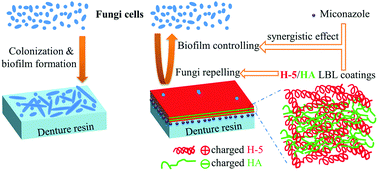Salivary polypeptide/hyaluronic acid multilayer coatings act as “fungal repellents” and prevent biofilm formation on biomaterials†
Abstract
Candida-associated denture stomatitis (CADS) is a common, recurring clinical complication in denture wearers that can lead to serious oral and systemic health problems. Current management strategies are not satisfactory due to their short-acting and ineffective therapeutic effects. Here, we describe a new fungal biofilm controlling strategy using the polyelectrolyte layer-by-layer (LBL) self-assembly technology on denture materials. Conventional poly(methyl methacrylate) (PMMA) denture material discs were functionalized with negatively charged poly(methacrylic acid) (PMAA) via plasma-initiated surface grafting, followed by repetitive alternating coating with the salivary antimicrobial polypeptide histatin 5 (H-5; cationic polymer) and hyaluronic acid (HA; anionic polymer). On the other hand, the H-5/HA LBL coatings (i.e., the outermost layer was H-5) inhibited fungal attachment/adhesion, significantly reduced fungal biofilm formation, and showed synergistic effects with the antifungal drug miconazole. LBL surface hydrophilicity was not the key mechanism in controlling Candida biofilm formation. The current approach demonstrates the utility of a new design principle for fabricating anticandidal denture materials, as well as potentially other related medical devices, for controlling fungal biofilm formation and combating insidious infections.



 Please wait while we load your content...
Please wait while we load your content...